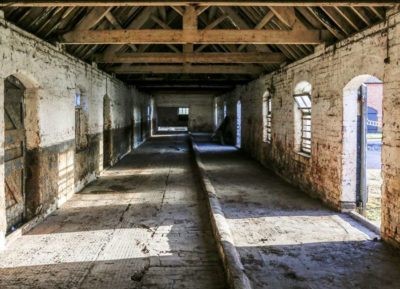Anthony Peers, architectural historian and Deputy Chairman of the Ancient Monuments Society, sets out the considerable challenges faced by historic farm buildings in an article for Historic England’s Heritage Online Debate.

‘Preserving Historic Farm Buildings Through Re-Use’ by Anthony Peers
I’ve been invited to contribute an article for Heritage Online Debate because I’ve long worked in the conservation field. In addition I care greatly about historic farm buildings and am concerned that we, the body politic, need to be doing more to address the considerable challenges they face.
I’ve lived for most of my life on a farm and now have the responsibility for a number of historic farm buildings. Most of these stand redundant. I’m interested in the march of progress in the field of agriculture and fully appreciate why old farm buildings have come to be outmoded.
In 2014, at the Heritage Alliance’s conference on the Future of Traditional Farm Buildings, one thing became all too clear to me. In the more densely populated, wealthier parts of the country the threats facing historic farm buildings are quite different from those faced by their counterparts in the backwaters. Where the key threat in well populated parts might relate to ill advised conversion, in truly rural parts dereliction is the number one threat. In my part of the world the ruinous farm building is coming to be a familiar sight.
I live in the north of Shropshire. Close by the Cheshire plain, this is grass growing dairy country. In the mid-19th century, during the golden years for farming, times were especially good here. The construction of a train line locally opened new markets to farmers. They could quickly and easily transport their dairy products to Liverpool, Manchester and Birmingham.
Almost without exception the farmers and landowners in this area re-invested their gains in state of the art farmsteads. These mid-Victorian farm buildings were carefully designed along the latest scientific principles. They were well built and detailed too, with no expense spared on materials. But these buildings were only ‘state of the art’ for a decade or two. Farming practices moved on.
Now in the early 21st century farming has moved on so far that most of these buildings are fit for only the most insignificant of agricultural purposes.
The mid-Victorian dairy farmsteads in my corner of the country were designed to house 30, maybe 40, cows maximum. The popular thinking nowadays is that to have any chance of staying afloat the dairy farmer must have at least 200 head. Around us 400 is more the norm. The brutal reality is that large herds are much more easily and efficiently looked after if housed in huge portal framed sheds. Either that or adopt the New Zealand system where the small hardy milkers are outside for 12 months a year. Whichever way, the historic farm buildings end up being surplus to requirement.
As Historic England’s Advice Note 9 clearly spells out – the old building which no longer has a viable use will be unlikely to attract funds for maintenance and repair. If the old buildings are no longer of use for farming then they need to be vested with new purposes. This is true but with historic farm buildings there are a few challenges which need to be overcome. Firstly it is a rare farmer who is happy having third parties living or plying their trade in the centre of his or her farming operations. Second, building conversions are costly and, in places where demand is weak, the rental returns against borrowing costs rarely add up. Thirdly, where demand is weak the developers are not interested in barn conversions. With any number of greenfield sites available to them at the moment, they will always chose to build on plots where they can roll out off the peg houses instead of getting involved in complicated, bespoke and financially risky conversion works.
There are hundreds of thousands of redundant or near redundant mid-Victorian farm buildings out there. Each faces a very uncertain future. They were generally very well built and they are very positive contributors to rural heritage. On environmental grounds historic farm buildings can be seen as great store houses of embodied energy awaiting utilisation.
The Historic England guidance documents for traditional farm buildings are balanced and carefully considered. The message is that in most instances adaptive re-use should be a viable option – if the works of conversion are planned from an informed standpoint.
In support of Historic England’s good work to date might I make a plea for more carrot and more stick? More carrot to support owners in securing new uses for their historic farm buildings. This might be achieved if the Government redoubles its efforts to encourage reluctant local authorities to appreciate the need to regard redundant historic farm buildings as special cases – so that in the future the fall back answer to the question ‘can we convert it?’ will in most instances be ‘yes’.
In order to protect farm buildings and their settings, the stick might come in the form of an insistence that all consents for conversion be caveated with restrictions on further developments in the vicinity.
In order to help the local authority assessors and put a check on ill-informed schemes, why not insist that (at the applicant’s expense) all applications be prepared with the benefit of a history appraisal document. This might be prepared along the lines of the examples set out in Historic England’s exemplary Farmstead Assessment Framework. From this document and the three excellent reports launched today, to the nation-wide coverage of Landscape Character Area Assessments and Historic Farmsteads Character Statements, there is clearly a wealth of invaluable guidance out there. My final plea is to Historic England. Please do as much as can be done to signpost owners, developers and assessors alike to the relevant guidance. My sense is that at present the message is not getting through. The guidance is all there – we know it, but the busy people at the coal face need to be helped to find it.
The article originally featured on Historic England’s ‘Heritage Online Debate’ here.
For current Historic England guidance on Farm Buildings and Traditional Farmsteads, click here.
Historic England’s Farmstead Assessment Framework can be found here.


